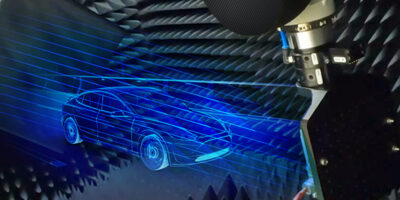Designers can reduce the complexity of 5G radio and reduce the number of components required, using a millimeter wave (mmW) 5G front-end chipset by Analog Devices.
It comprises two single channel (1T1R) up / down converters (UDCs) and two dual polarisation 16-channel beamformer devices on a CMOS process. The power efficiency and linear output power provided by the beamformers enable size, weight, power, and cost reduction in mmW phased array designs compared to competing solutions, claims Analog Devices. The full-band UDCs with high drive level eliminate the need for frequency band variants and absorb driver stages for bill of materials savings.
The mmW 5G front-end chipset includes four devices from Analog Devices, the ADMV4828, the ADMV4928, the ADMV1128 and ADMV1139.
The ADMV4828 is a16-channel beamformer covering the 24 to 29.5GHz band in a single IC with more than 12.5dBm output power at three per cent error vector measurement (EVM) with a 400MHz 64QAM 5G NR (new radio) waveform while consuming only 310mW per channel.
The ADMV4928 is a 16-channel beamformer covering the 37 to 43.5GHz band in a single IC with above 11.5dBm output power at three per cent EVM with a 400MHz 64QAM 5G NR waveform while consuming only 340mW per channel.
The ADMV1128 is the company’s 24GHz to 29.5GHz wideband UDC with optional on-chip RF switch and hybrid, x2 /x4 local oscillator (LO) multiplier modes and baseband IQ support.
The fourth element is the ADMV1139, a 37 to 50GHz wideband UDC suitable for the upcoming 47GHz, as well as the 37 to 43.5GHz 5G NR bands. The single IC has optional on-chip RF switch and hybrid, with baseband IQ support.
The chipset enables seamless operation of phased array calibration functions online in the field in addition to factory non-volatile memory (NVM) through patented IP. This allows OEMs to move beyond the constraints of legacy NVM-only designs limited to one-time factory calibration of the beamformer, which does not address non-idealities external to the ICs and results in sub-optimal calibration results.
Analog Devices adds that mmW 5G deployment highlights the need for operators to expand their network footprint with more energy efficient, lightweight, and reliable radios. This requires highly linear, compact, and power efficient wideband products that allow design reuse over multiple bands without compromising on quality and performance. Analog Devices says that this mmW 5G front-end chipset allows OEMs to depart from the narrowband paradigm where competing solutions have traded-off design execution difficulty and RF performance for bandwidth, while also outsourcing critical pieces of IP such as packaging, test, and thermal modelling.
The company also offers in-house quality management and package development, enabling engineers to create reliable, fully optimised, and customisable 5G radios quickly.







